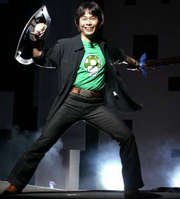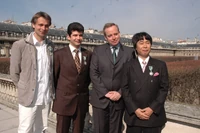- "Games should be something everybody wants to play."
- — Shigeru Miyamoto
Shigeru Miyamoto (宮本 茂 Miyamoto Shigeru?, born November 16, 1952) is a Japanese video game designer. He is the creator of the Legend of Zelda series along with other famous video game franchises such as the Mario, Donkey Kong, Star Fox and Pikmin video game franchises for Nintendo game systems.
Miyamoto is one of the world's most celebrated game designers, and is often called one of the fathers of modern video-gaming. His titles are characterized by refined control-mechanics and imaginative worlds in which the players are encouraged to discover things for themselves, as well as basic storylines, which had been almost unheard of before he introduced one of the first, featuring Mario.
Employed by Nintendo (then a Hanafuda manufacturer) as an artist, in 1980 he was given the task of designing one of their first coin-op arcade games. The resulting title Donkey Kong was a huge success and the game's lead character, Jump Man - later renamed Mario - has become Nintendo's mascot. Miyamoto quickly became Nintendo's star producer designing many franchises for the company, most of which are still active and very well-regarded.
Shigeru Miyamoto has two children with his wife, Yasuko Miyamoto, who was general manager of Nintendo of Japan in 1977; both parents have worked for Nintendo, but neither of their children have expressed any desire to go into the family business.
He is currently the Director and General Manager of Nintendo Entertainment Analysis and Development (EAD), the corporate sector of Nintendo of Japan. In 1998, Miyamoto became the first person to be inducted into the Academy of Interactive Arts and Sciences' Hall of Fame.
Biography[]
Shigeru Miyamoto was born in Sonobe (now Nantan), Kyoto, Japan. As a young boy, Miyamoto loved to draw, paint pictures, and explore the landscape surrounding his home. Stories describe his fascinated discovery of hidden caves, lakes, and other natural features that were linked to his later work. In 1970, he enrolled in the Kanazawa College of Art, and graduated five years later, though he would later remark that his studies often took a backseat to doodling. In 1977, Miyamoto, armed with a degree in industrial design, was able to arrange a meeting with Hiroshi Yamauchi, a friend of his father and the head of Nintendo of Japan. Yamauchi hired Miyamoto to be a "staff artist", even though one was not needed at the time, and assigned him to apprentice in the planning department.

Shigeru Miyamoto wielding a replica Master Sword and Hylian Shield at the 2004 Electronic Entertainment Expo
In 1980, the fairly new Nintendo of America was looking for a hit to establish itself as a player in the growing arcade market. After successful location tests using prototypes, Nintendo of America CEO Minoru Arakawa ordered a very large number of units of Radar Scope, an arcade game. However, by the time the arcade machines could be produced and shipped to the U.S., interest had vaporized, causing Radar Scope to be a huge flop. To stay afloat and clear the costly inventory of Radar Scope Nintendo of America desperately needed a smash-hit game that the unsold machines could be converted to play. Yamauchi assigned Miyamoto — the only person available — the task of creating the game that would make or break the company.
After Miyamoto had consulted with some of the company's engineers (he had no prior programming experience), and composed the music himself on a small electronic keyboard, Donkey Kong was fully conceptualized. When the game was complete, the chips containing the new program were rushed to the U.S. and Nintendo employees worked around the clock to convert the Radar Scope machines. It was fortuitous that Nintendo had so many units on hand, because Donkey Kong was an overnight success, and not only saved the company, but introduced the character who more than any other would be identified with Nintendo (Mario).

Shigeru Miyamoto (right) with fellow game designers Michel Ancel (left) and Frédérick Raynal as well as French minister of culture Renaud Donnedieu de Vabres (center) on March 13, 2006 above the Palais Royal gardens in Paris.
Despite being an influential figure in video games and responsible for multi-million dollar franchises, Miyamoto is said to be very humble, insisting on settling for an average income, and often rides a bicycle to work.
Miyamoto was the first member ever to be inducted into the Academy of Interactive Arts and Sciences' Hall of Fame in 1998, an award that outlines his lifetime achievement and dramatic effect on the video game industry. In March 2005, Miyamoto was among the first honorees in 2004 to receive a star on the Walk of Game, a section of San Francisco's Metreon Center that is modeled on Hollywood's Walk of Fame.
On March 13, 2006, Miyamoto received a French honor, by being inducted Chevalier ("Knight") into the Ordre des Arts et des Lettres, alongside game designers Michel Ancel and Frédérick Raynal as part of the French video game policy effort.
Delays in releases[]
- "A delayed game is eventually good, but a rushed game is forever bad."
- — Shigeru Miyamoto
Nintendo is known for delaying the release of its games. This is largely due to the perfectionist tendency of Miyamoto who would go as far as scrapping the entire development if he did not find a game up to his standard. Miyamoto and fellow developers refer to this scrapping as "Chabudai Gaeshi" (upending the tea table), a reference to manga and anime Hoshi of the Giants. It is also referred to as "Miyahon Check" (Miyahon is an alternative kanji reading of Miyamoto) or "Miyamoto Test".
For example, "Twinkle Popo" was a completed product with a pre-order of 26,000 units. It was supposed to be released under the game's developer, HAL Laboratory. Miyamoto intervened arguing that, with a tiny bit of tweaking, it would become a great game. After canceling the preorder, the game was eventually released under Nintendo with the title Kirby's Dream Land, selling 5,000,000 units globally.
The Legend of Zelda: Ocarina of Time was supposed to be released immediately after the release of the Nintendo 64. Instead, Miyamoto, who was the producer, repeatedly ordered the game to be redone, resulting in numerous announcements of delays by Nintendo until the game's eventual release on 11/21/1998. Eiji Aonuma was initially the producer of The Legend of Zelda: Twilight Princess. However, between 2005 to 2006, he switched to the director's role. He stated that the switch was the result of a year-long development being "Chabudai Gaeshi"ed. In the same interview, Miyamoto stated that he had to clean up the mess of his Chabudai Gaeshi, so he joined in as a producer and also help out the development of the game.
External links[]
- Miyamoto Shrine—A website dedicated to Shigeru Miyamoto
- N-Sider—Shigeru Miyamoto profile
- Shigeru Miyamoto at the Internet Movie Database
- Short documentary of Miyamoto's work
- Shigeru Miyamoto profile on MobyGames
- In-depth Interview 2006
